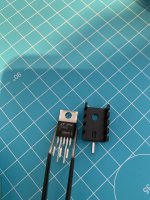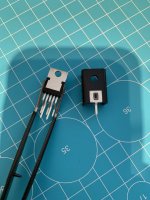Yes both channels are affected. I will throughly inspect today. Thanks for your helpProblem is maybe not there...sometimes it is difficult to find for simple enthusiasts as us...
Is it on both channels or one ? Same channel is scratching if you invert the oaps from their socket ? Little by little you may be able to reduce the possibilities...
Since I’m ordering from mouser some additional parts, can you please suggest some opamps to try? I may as well order some others just to try. I’m looking for dip8 ic’s only. Here’s my list:Looking at your work here https://www.diyaudio.com/community/...st-tht-i2s-input-nos-r-2r.354078/post-6992778 all seem very clean.
Some ideas meanwhile the dip8 arrival :
Check the JLsounds I2S set up at its the bottom as per what has been explained in the thread.
The traffo seems far enough but try to put a tin above to reassure you about coupled field.
Does the streamer does not upsample all your material, check if the same clicks occur at different sampling speeds : 44khz to 388khz.
Check also with magnyfing glass around the registers and their caps if it is clean. Idem around the jlsounds and the dac pcb...
Certainly the oaps but who knows, it costs nothing to check.
Burson V6 , OPA 1611, OPA 1655 and ADA 4898-1. Other suggestions please
Looks like none of the opamps I’m interested in are available from mouser in dip 8 package 😕
The bursons were out of stock through the diyAudio store so I ordered direct from burson a pair of V6 single. Will continue looking 😞
Last edited:
I’m not really sure you even need the heatsinks but since you have them go ahead and use them. In my opinion you definitely don’t need the thermal pads.
And you don’t need the mounting pin on the back of the heatsink. You can just bend them and they will pop right off.
It’s exactly how I installed mine.
I just used a stainless screw and nylock nut to attach the sink to the regulators
Hope this helps
And you don’t need the mounting pin on the back of the heatsink. You can just bend them and they will pop right off.
It’s exactly how I installed mine.
I just used a stainless screw and nylock nut to attach the sink to the regulators
Hope this helps
Attachments
Last edited:
Yep - snip that pin off the bottom of the heatsink with a snips.
If you have it to hand, I would use a thermal pad or paste and mica, and an insulated shoulder washer. Belt and braces I know, but I would be wary of the heatsinks touching each other, and shorting the input for LT3015 to ground (the metal tab of the LT3015 is the same as the input pin, and the metal tab of the LT1963 is ground).... maybe it is the other way around, but from memory they are not both ground and therefore you are better off making sure they do no short together. You are probably safer not using a heatsink if you are not going to insulate the heatsink from the tab. Also from memory - they are pretty close to each other with the heatsinks in place.
If you have it to hand, I would use a thermal pad or paste and mica, and an insulated shoulder washer. Belt and braces I know, but I would be wary of the heatsinks touching each other, and shorting the input for LT3015 to ground (the metal tab of the LT3015 is the same as the input pin, and the metal tab of the LT1963 is ground).... maybe it is the other way around, but from memory they are not both ground and therefore you are better off making sure they do no short together. You are probably safer not using a heatsink if you are not going to insulate the heatsink from the tab. Also from memory - they are pretty close to each other with the heatsinks in place.
Mica and paste, or one of those fancy thermal pads that don't need paste..... but insulating the metal tabs from the heatsinks in case the heatsinks touch - it happens easier than you'd think as you're assembling/testing things, and these regulators are hard to get now.
It depends on how close the heatsinks are to each other when assembled on the regulators and sitting in their positions. Smaller heatsinks, less worry about this.
It depends on how close the heatsinks are to each other when assembled on the regulators and sitting in their positions. Smaller heatsinks, less worry about this.
Those heat sinks are not very flat, so they may actually be more effective when used with the isolation pads and
thermal compound, even if you don't need them.
thermal compound, even if you don't need them.
Ок but first I want to burn in the device, understand the sound with 6171 and after I will be looking the others opamps@sworder84 You can try OPA177 and OPA134 in the I/V 🙂
@miro1360.
Hi
Any thougths or tries with curent feedback oaps?
LM6181, AD811, OPA 837...
In theory the curent feedbackloop should nicer on a wider bandwidth (more constant?) ...at least my basic undetstanding.
But they seems not to have much sucess over the voltage controled feedback oaps... any reasons?
Hi
Any thougths or tries with curent feedback oaps?
LM6181, AD811, OPA 837...
In theory the curent feedbackloop should nicer on a wider bandwidth (more constant?) ...at least my basic undetstanding.
But they seems not to have much sucess over the voltage controled feedback oaps... any reasons?
Miro closest to PCM1704 is OPA627AP and other is OPA214PA acording to this photo@sworder84 Definitely play with different OpAmps. For more colored sound try OPA134 😉
Dodson 214 mk2-d uses PCM1704 as DAC. Can you check and tell us what are the OpAmps in this device? Especially the one OpAmp next to the PCM1704 chip.
I used AD811 for a while until I switched to tubes. In fact, it is not easy to perform in diy, you should pay attention to everything as if it were in the HF area, because it is an op.amp that goes up to 140MHz and 2500V/μs slew.@miro1360.
Hi
Any thougths or tries with curent feedback oaps?
LM6181, AD811, OPA 837...
In theory the curent feedbackloop should nicer on a wider bandwidth (more constant?) ...at least my basic undetstanding.
But they seems not to have much sucess over the voltage controled feedback oaps... any reasons?
I had the help of an engineer who has worked with antennas and transmitters all his life and who has already worked with the AD811.
Is it better? Honestly, if done well it will sound better than any op.amp with voltage feedback.
Attachments
Miro closest to PCM1704 is OPA627AP and other is OPA214PA acording to this photo
Thank you @Ripster, the OPA627 in the I/V must perform really well 🤩
@miro1360.
Hi
Any thougths or tries with curent feedback oaps?
LM6181, AD811, OPA 837...
In theory the curent feedbackloop should nicer on a wider bandwidth (more constant?) ...at least my basic undetstanding.
But they seems not to have much sucess over the voltage controled feedback oaps... any reasons?
CFA is always little tricky. I will test LM6181 in the future, it looks great, thanks for this tip 👍 🤓
I knew T loesh liked the opa837 for the people wanting avoiding tubes, but the guys have acess to wide bandwidth scopes most non pro enthusiasts haven't.
As with P Rogic when using the opa861 as a buffer without feedback and close decoupling.. he knows what he is doing and for sure measure it ! 🙂
As for the input isolation process like the opa627, most new Ti's chips profite of what was expensive with the opa627 : the opa 810 and 1641, alas only soic are certainly better than the 627 and has those isolation input process with the next stage in the oaps that also made special the opa627 (my very basic understanding as a noob).
So imho Info @intojazz should cope with the AD797 if dip8 casing is what he wants to do for the size ... or invest in multiple boards testing and solder the oaps without sockets to test (ask some here, it can be adictive, isn't guys 😉 . I also do it for the caps guys and you don't surmise how big are the margins in sound improvement when you setup it haute couture in relation with the rest of your own system... never forgett that what you hear is the sum of all the chain 🙂
Edit : personal 'pinion : my ears never liked the 2134....
As with P Rogic when using the opa861 as a buffer without feedback and close decoupling.. he knows what he is doing and for sure measure it ! 🙂
As for the input isolation process like the opa627, most new Ti's chips profite of what was expensive with the opa627 : the opa 810 and 1641, alas only soic are certainly better than the 627 and has those isolation input process with the next stage in the oaps that also made special the opa627 (my very basic understanding as a noob).
So imho Info @intojazz should cope with the AD797 if dip8 casing is what he wants to do for the size ... or invest in multiple boards testing and solder the oaps without sockets to test (ask some here, it can be adictive, isn't guys 😉 . I also do it for the caps guys and you don't surmise how big are the margins in sound improvement when you setup it haute couture in relation with the rest of your own system... never forgett that what you hear is the sum of all the chain 🙂
Edit : personal 'pinion : my ears never liked the 2134....
Last edited:
- Home
- Source & Line
- Digital Line Level
- DAC AD1862: Almost THT, I2S input, NOS, R-2R




